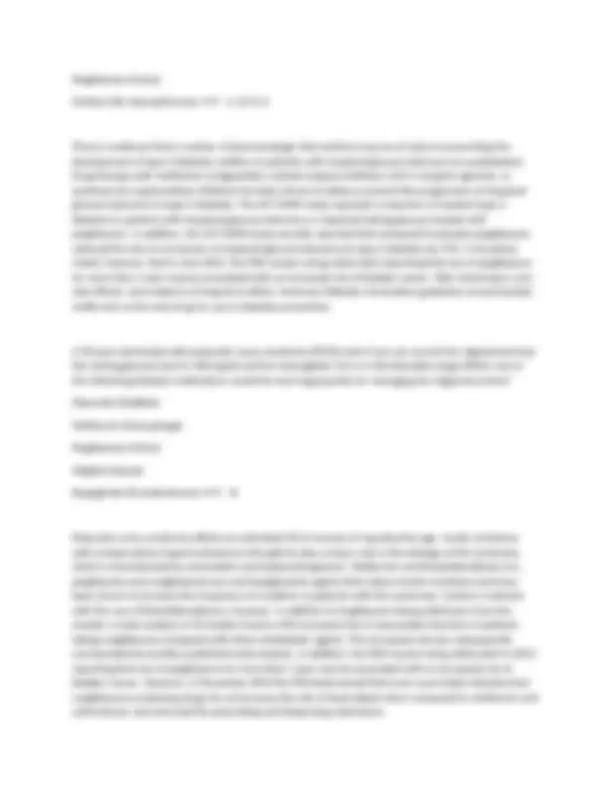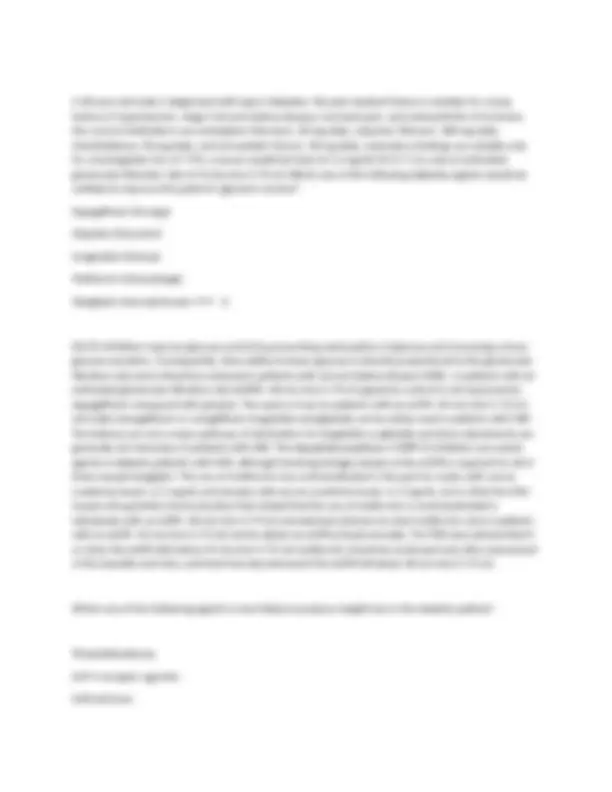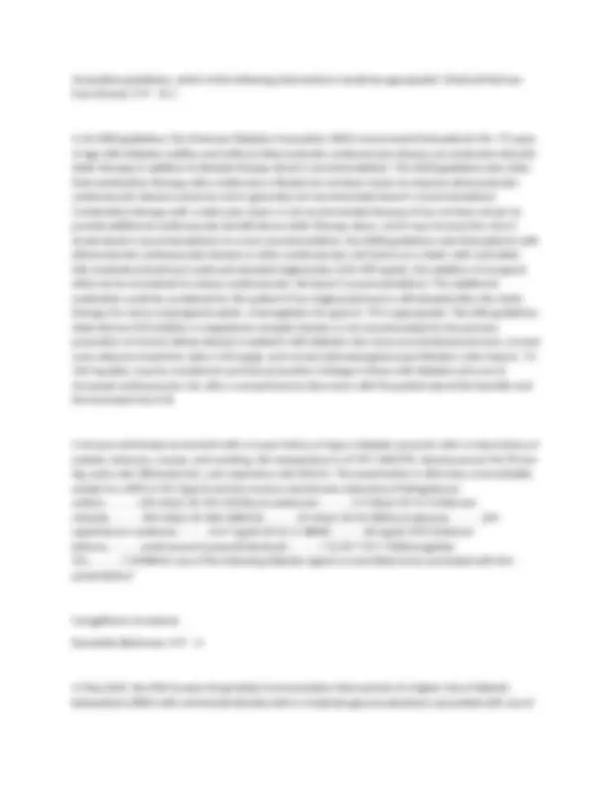




























Study with the several resources on Docsity

Earn points by helping other students or get them with a premium plan


Prepare for your exams
Study with the several resources on Docsity

Earn points to download
Earn points by helping other students or get them with a premium plan
Community
Ask the community for help and clear up your study doubts
Discover the best universities in your country according to Docsity users
Free resources
Download our free guides on studying techniques, anxiety management strategies, and thesis advice from Docsity tutors
The appropriate initial intervention for a 42-year-old obese male with an impaired fasting glucose level of 118 mg/dl, as per the american diabetes association guidelines. The document also covers prediabetes, hemoglobin a1c, cardiovascular risk factors, and the leader trial, which examines the use of liraglutide in patients with type 2 diabetes at high cardiovascular risk.
Typology: Exams
1 / 34

This page cannot be seen from the preview
Don't miss anything!



























True statements regarding nonpharmacologic therapy to reduce insulin resistance include which of the following? (Mark all that are true.) Decreasing caloric intake will increase insulin sensitivity independent of weight loss Moderate alcohol intake increases insulin resistance Exercise has been shown to enhance insulin action in skeletal muscle A decrease of as little as 5% in body weight can result in a substantial reduction in insulin resistance If there are no contraindications, patients with insulin resistance syndrome should be advised to engage in 30 minutes of modest aerobic exercise at least 4-5 times/weekAnswer ✔✔ - A, C, D, E Lifestyle interventions play a pivotal role in the management of insulin resistance syndrome. Losing even 5% of body weight has been shown to substantially reduce insulin resistance. In addition, insulin sensitivity can be increased by reducing caloric intake, even if no weight is lost. Exercise is an important adjunct to weight loss, since it has been shown to enhance insulin action in skeletal muscle not only during physical activity but for up to a week following exercise. All patients with insulin resistance syndrome should be advised to engage in 30 minutes of aerobic exercise at least 4-5 times/week. Moderate alcohol intake lowers insulin resistance. Which one of the following neurologic tests is most useful for predicting the future occurrence of a diabetic foot ulcer? Pressure sensation with Semmes-Weinstein monofilament (10 g) Deep tendon reflexes of the ankle Proprioception Vibratory sensation with a 128-mHz tuning fork Light touch with a wisp of cottonAnswer ✔✔ - A Failure to perceive a pressure sensation produced by Semmes-Weinstein monofilament indicates a loss of protective sensation in the diabetic foot and is highly predictive of foot ulceration. Traditional
neurologic examination techniques for evaluating reflexes, proprioception, vibration, or light touch are highly subjective and less predictive of future ulceration. Which of the following lipid-lowering agents can worsen glycemic control? (Mark all that are true.) Colestipol (Colestid) Ezetimibe (Zetia) Gemfibrozil (Lopid) Niacin Atorvastatin (Lipitor)Answer ✔✔ - D AND E Niacin is not only the most effective agent for raising HDL-cholesterol, producing an increase of 15%- 35%, it also reduces triglycerides by 20%-50% and LDL-cholesterol by 5%-25%. Hyperglycemia is a side effect of niacin therapy, particularly at high doses. A dosage of 750-2000 mg/day is associated with only moderate rises in blood glucose, and at one time was considered a treatment option in patients with diabetes, particularly those with low HDL-cholesterol levels. However, the recommendations for niacin use were changed as a result of the AIM-HIGH trial (Atherothrombosis Intervention in Metabolic Syndrome with Low HDL/High Triglycerides: Impact on Global Health Outcomes), which found no incremental clinical benefit from the addition of niacin to statin therapy in patients with coronary heart disease and LDL-cholesterol levels >70 mg/dL.Recent studies support a link between statin use and the development of diabetes mellitus. In a meta-analysis of 13 studies, statin therapy was associated with a 9% increased risk for incident diabetes. Another meta-analysis corroborated this result and found that intensive-dose statin therapy was associated with a higher risk of new-onset diabetes compared with moderate-dose statin therapy. In 2012, the FDA modified the package labeling of statins to include the risk of increased blood glucose levels and the development of type 2 diabetes. The benefit of statin therapy, however, outweighs the risk; it was estimated there would be 1 additional case of diabetes for every 498 patients treated for 1 year, compared with 1 less patient experiencing a cardiovascular event for every 155 patients treated for 1 year. A 58-year-old male with type 2 diabetes mellitus comes in during the early afternoon for his annual physical examination. His current medication regimen consists of insulin glargine (Lantus), 18 units in the evening; glipizide (Glucotrol), 20 mg/day; metformin (Glucophage), 1000 mg twice a day; and acarbose (Precose), 100 mg three times a day. He suddenly becomes shaky, diaphoretic, and pale, and tells you he thinks it is because he skipped lunch before his appointment.Which of the following would be effective for managing this episode? (Mark all that are true.) Glucose tablets
6 months later for a follow-up visit, and a spot urine sample has an albumin/creatinine ratio of 45 μg/mg.Which one of the following would be most appropriate initially? Have the patient return in 6 months for a repeat urine test for albumin and creatinine Order a 24-hour urine collection for creatinine Recommend that the patienAnswer ✔✔ - E Diabetic nephropathy develops in 20%-40% of patients with diabetes, and is the leading cause of end- stage renal disease. Persistent albuminuria in the range of 30-200 mg/24 hr (microalbuminuria) is the earliest sign of nephropathy in patients with type 1 diabetes, and is a marker for nephropathy in type 2 diabetes. Patients with microalbuminuria who progress to macroalbuminuria (>300 mg/24 hr) are likely to progress to end-stage renal disease over a period of years.Although timed 4- and 24-hour urine collections for creatinine can be used to screen for microalbuminuria, a random spot urine specimen for measurement of the albumin-to-creatinine ratio is the preferred method. A minimum of two of three tests showing a urine albumin level >30 μg/mg creatinine or more over a 6-month period confirms the diagnosis of microalbuminuria.Intensive diabetic management and the use of ACE inhibitors and angiotensin receptor blockers (ARBs) have been shown to delay the progression from microalbuminuria to macroalbuminuria in patients with type 1 or type 2 diabetes. Since the antiproteinuric effect is believed to be independent of blood pressure, current ADA guidelines recommend the use of ACE inhibitors or ARBs as first-line therapy for both type 1 and type 2 diabetic patients with microalbuminuria, even if their blood pressure is normal. Some studies, however, have raised questions about the value of early renin-angiotensin blockade for preventing microalbuminuria in normotensive patients with type 1 or type 2 diabetes, and ADA guidelines recommend against the use of these drugs for patients with normal blood pressure and no albuminuria.Compared to whites, African-Americans and Asians have a three- to fourfold higher risk of angioedema associated with the use of ACE inhibitors. The American Heart Association recommends that ACE i True statements regarding carbohydrate intake and diabetes mellitus include which of the following? (Mark all that are true.) The glycemic index is not useful in the management of diabetes mellitus Carbohydrate sources high in protein are effective for treating hypoglycemia Low-fat diets are more effective for achieving weight loss than low-carbohydrate diets (<130 g/day) Excessive intake of sugar-sweetened beverages has been shown to increase the risk for diabetes mellitus Carbohydrates have fewer calories per gram than alcoholAnswer ✔✔ - D AND E
Weight loss is an important therapeutic objective in overweight or obese individuals with prediabetes or diabetes mellitus. Although low-fat diets have traditionally been promoted for weight loss, studies indicate that diets that provide the same caloric restriction but differ in protein, carbohydrate, or fat content are equally effective (SOR A). Both the amount and type of carbohydrates in food influence blood glucose levels. Monitoring the total grams of carbohydrates and using the glycemic index are both regarded as helpful strategies for achieving glycemic control. Dietary sucrose does not increase glycemia more than isocaloric amounts of starch, and intake of sucrose and sucrose-containing foods does not need to be restricted because of concerns about aggravating hyperglycemia in patients with diabetes mellitus. The use of nonnutritive sweeteners in place of caloric sweeteners has the potential to reduce carbohydrate intake. However, it has been shown that consumption of excessive amounts of sugar- sweetened beverages by nondiabetic persons is associated with a greater risk of developing type 2 diabetes. Although the energy content of alcohol is approximately 7 kcal/g, compared to 4 kcal/g for carbohydrates, alcohol consumption may place patients with diabetes at higher risk for hypoglycemia, especially if they are on insulin or insulin secretagogues. A 51-year-old male with type 2 diabetes mellitus controlled with diet is found to have a serum triglyceride level of 350 mg/dL, an LDL-cholesterol level of 101 mg/dL, and an HDL-cholesterol level of 45 mg/dL.Which one of the following supplements would most likely reduce his serum triglyceride levels? Vitamin E Vitamin C Omega-3 fatty acids Folate ChromiumAnswer ✔✔ - C At a dosage of approximately 3 g/day, omega-3 (or n-3) fatty acids have been reported to reduce serum triglyceride concentrations by 25%-30%, with accompanying increases in LDL-cholesterol of 5%-10%, and in HDL-cholesterol of 1%-3%. Which one of the following is INEFFECTIVE for treating pain syndromes arising from diabetic neuropathy? Tricyclic antidepressants SSRIs Duloxetine (Cymbalta) Pregabalin (Lyrica)Answer ✔✔ - B
these episodes have occurred during walks he takes with his wife before eating lunch.Which one of the following would be the most appropriate management? Reducing his metformin dosage to 500 mg in the morning DiscontinuiAnswer ✔✔ - B Although studies have clearly shown that intensive glycemic control reduces the risk for microvascular complications in patients with diabetes, it remains unclear whether it reduces the risk for cardiovascular disease as well. ACCORD, ADVANCE, and the Veterans Affairs Diabetes Trial have failed to show benefit, and the ACCORD trial actually reported an increased mortality rate in patients with type 2 diabetes treated with intensive therapy with a target hemoglobin A1c of <6.0%. Subjects in the ACCORD trial averaged 62 years of age and had diabetes for a mean duration of 10 years. Subjects either had a history of a cardiovascular disease (CVD) event between the ages 40 and 79, or had significant CVD risk and were between the ages 55 and 79. Based on the data available, the American Diabetes Association, in association with the American College of Cardiology Foundation and the American Heart Association, issued a position statement advising that less stringent hemoglobin A1c goals may be appropriate for patients with a history of severe hypoglycemia, limited life expectancy, advanced microvascular or macrovascular complications, poor health, or long-standing diabetes mellitus recalcitrant to therapy. A hemoglobin A1c of <7.0% is still recommended for the majority of patients with diabetes mellitus, with a target hemoglobin A1c closer to normal reserved for healthy patients with a short duration of disease and a long life expectancy (SOR C). True statments regarding dipeptidyl peptidase-4 inhibitors include which of the following? (Mark all that are true.) They are more effective than metformin for lowering hemoglobin A1c They reduce insulin resistance They augment glucagon secretion They are weight neutral They are not associated with hypoglycemiaAnswer ✔✔ - D AND E Oral dipeptidyl peptidase-4 (DPP-4) inhibitors are oral hypoglycemic agents that work by enhancing circulating concentrations of active glucagon-like peptide 1 (GLP-1) and glucose-dependent insulinotropic peptide (GIP). These agents lower glucose by increasing insulin secretion and reducing glucagon secretion in a glucose-dependent manner. Oral DPP-4 inhibitors are generally felt to be less effective than metformin and the sulfonylureas for lowering glucose, with an expected HbA1c reduction
in the range of 0.5%-1.0% compared to 1.0%-1.5% for metformin and the sulfonylureas. DPP-4 inhibitors are considered weight neutral and are not associated with hypoglycemia. Side effects include nasopharyngitis, upper respiratory tract infection, and headache. A 62-year-old male sees you for the first time. His past medical history is notable for a long history of type 2 diabetes and hypertension, as well as a history of myocardial infarction 5 years ago and New York Heart Association class III heart failure. His current medications are hydrochlorothiazide, 25 mg daily; valsartan (Diovan), 320 mg daily; metoprolol succinate (Toprol XL), 50 mg daily, metformin (Glucophage), 850 mg twice daily; rosuvastatin (Crestor), 20 mg daily; and aspirin, 81 mg daily. Notable findings on examination include a blood pressure of 135/84 mm Hg and a heart rate of 58 beats/min. Laboratory findings include a hemoglobin A1C of 7.8%, an LDL-cholesterol level of 70 mg/dL, an HDL- cholesterol level of 35 mg/dL, a serum triglyceride level of 210 mg/dL, and an estimated glomerular filtration rate of 71 mL/min/1.73 m2.Which one of the following has been shown to reduce cardiovascular risk in patientsAnswer ✔✔ - B The LEADER trial (Liraglutide Effect and Action in Diabetes: Evaluation of Cardiovascular Outcome Results) was a double-blind trial that compared the use of liraglutide, a GLP-1 analogue, to placebo in 9340 patients with type 2 diabetes at high cardiovascular risk. After a mean follow-up of 3.8 years, liraglutide was found to significantly reduce the rate of death from cardiovascular causes, as well as the first occurrence of nonfatal myocardial infarction and nonfatal stroke (hazard ratio, 0.87; 95% confidence interval [CI], 0.78 to 0.97). The rate of death from any cause was also reduced (SOR B).Cardiovascular outcome studies evaluating DPP-4 inhibitors such as sitagliptin, saxagliptin, and alogliptin have yet to demonstrate a significant reduction in adverse cardiovascular events in patients with diabetes. In addition, the SAVOR-TIMI trial (Saxagliptin Assessment of Vascular Outcomes Recorded in Patients with Diabetes Mellitus—TIMI 53) reported a higher risk for hospitalization for heart failure associated with saxagliptin treatment compared to placebo. Although a reduced risk for stroke has been reported with pioglitazone, thiozolidenediones are associated with fluid retention, which can lead to weight gain, edema, and heart failure. Their use is contraindicated in patients with New York Heart Association class III or IV heart failure. Oral sulfonylureas are potent glucose-lowering agents associated with a higher risk for hypoglycemia. Studies have not shown a reduced cardiovascular risk with their use, and the University Group Diabetes Program (UGDP) trial reported a higher risk of cardiovascular death associated with the use of tolbutamide.Although niacin might have been a consideration in the past in an effort to raise HDL-cholesterol and lower triglycerides, support for its use was dampened by the findings A 66-year-old male who was hospitalized because of a TIA 3 months ago sees you for a follow-up visit. His past medical history is notable for impaired fasting glucose and mild hypertension. His current medications are valsartan (Diovan), 160 mg daily; rosuvastatin (Crestor), 20 mg daily; and aspirin, 81 mg daily. On examination his BMI is 30.2 kg/m2, his blood pressure is 134/86 mm Hg, and he has brown, velvety, hyperkeratotic plaques on the back of his neck and in his axilla. His laboratory studies are notable for an LDL-cholesterol level of 85 mg/dL, an HDL-cholesterol level of 35 mg/dL, and a serum
safety alert reporting that use of pioglitazone for more than 1 year may be associated with an increased risk of bladder cancer. True statements regarding dietary fat intake in patients with diabetes mellitus include which of the following? (Mark all that are true.) A Mediterranean-style diet rich in monounsaturated fats has been shown to improve glycemic control in patients with diabetes Trans fatty acids have been shown to lower LDL-cholesterol and raise HDL-cholesterol Saturated fats should provide 10% of caloric intake Omega-3 (or n-3) fatty acid supplementation is associated with a cardioprotective effect A gram of fat contains 50% more calories than a gram of carbohydrateAnswer ✔✔ - A The primary goal with regard to fat intake in patients with diabetes is to limit saturated fat and trans fatty acids. National dietary guidelines recommend that intake of saturated fat be limited to <10% of daily calories. Intake of trans unsaturated fatty acids should be minimized, since they have been shown to raise LDL-cholesterol and lower HDL-cholesterol. A Mediterranean-style diet rich in monunsaturated fats has been found to improve both glycemic control and lipid levels in patients with diabetes. Randomized, controlled trials do not support recommending omega-3 supplements for primary or secondary prevention of cardiovascular disease. A gram of fat contains more than twice the calories of a gram of carbohydrate. True statements regarding coronary heart disease in patients with diabetes mellitus include which of the following? (Mark all that are true.) Routine screening with a cardiac stress test is recommended in asymptomatic patients with diabetes who are at increased cardiovascular risk β-Blockers should be avoided in diabetic patients with coronary artery disease, due to the risk of masking hypoglycemia and reducing insulin secretion Long-term outcomes following percutaneous transluminal coronary angioplasty are as good in diabetic patients as in nondiabetic patients The survival of diabetic patients with multivessel disease is better with coronary revascularization with coronary artery bypass graft (CABG) surgery than with percutaneous transluminal coronary angioplasty
Optimal glycemic control has been shown to reduce the risk of coronary heart disease in patients with type 2 diabetesAnswer ✔✔ - D Although atherosclerotic cardiovascular disease is the leading cause of morbidity and mortality in patients with diabetes, routine screening for coronary heart disease is not recommended since it has not been shown to improve cardiovascular outcomes provided cardiovascular risk factors are treated (SOR A). The potential benefit of β-blockers in the diabetic patient with coronary artery disease outweighs the potential risk of masking hypoglycemia or reducing insulin secretion (SOR A). Good glycemic control has been shown to reduce microvascular complications in patients with diabetes mellitus. Although the Diabetes Control and Complications Trial and the Epidemiology of Diabetes Interventions and Complications study found that intensive glycemic control initiated soon after the diagnosis of type 1 diabetes produced long-term protection from cardiovascular disease, the results of three large trials (ACCORD, ADVANCE, and VADT) published in 2008 suggested no reduction in cardiovascular disease risk with intensive glycemic control in patients with type 2 diabetes. Mortality rates after percutaneous transluminal coronary angioplasty (PTCA) are generally higher in patients with diabetes mellitus than in nondiabetic patients. The survival of diabetic patients with multivessel disease is better after coronary artery bypass graft (CABG) surgery than after PTCA. This was shown in the FREEDOM trial (Future Revascularization Evaluation in Patients with Diabetes Mellitus: Optimal Management of Multivessel Disease), a randomized trial of 1900 patients with diabetes and multivessel coronary heart disease. Treatment with CABG was associated with both a lower rate of myocardial infarction and lower mortality compared to PCI with drug-eluting stents (SOR A). A 62-year-old African-American male with a 10-year history of type 2 diabetes is diagnosed with hypertension. His current medications include metformin (Glucophage XR), 1500 mg daily; sitagliptin (Januvia), 100 mg daily; and simvastatin (Zocor), 40 mg daily. His blood pressure at today's visit is 154/ mm Hg. His urine is negative for microalbuminuria.Which one of the following is true regarding treatment recommendations for this patient? Current American Diabetes Association (ADA) guidelines recommend treatment to a systolic blood pressure goal of <130 mm Hg and a diastolic blood pressure goal of <85 mm Hg JNC 8 guidelines recommend treatment to a systolic blood pressure goal <150 mm Hg and a diastolic blood pressure goal of <90 mm Hg The SPRINT trial supports targeting a systolic blood pressure goal of <120 mm Hg ADA guidelines recommend initiating therapy with either an ACE inhibitor or an angiotensin receptor bAnswer ✔✔ - E Although randomized clinical trials have shown the cardiovascular and renal benefit of antihypertensive treatment targeting a systolic blood pressure <140 mm Hg and a diastolic blood pressure <90 mm Hg,
An HDL-cholesterol level <50 mg/dL in females An LDL-cholesterol level ≥160 mg/dL A serum triglyceride level ≥150 mg/dL Diastolic blood pressure ≥85 mm HgAnswer ✔✔ - A, B, D, E Metabolic syndrome is a constellation of cardiovascular risk factors related to hypertension, abdominal obesity, dyslipidemia, and insulin resistance. Diagnostic criteria for metabolic syndrome, according to the National Cholesterol Education Program (Adult Treatment Panel III Guidelines), include the presence of three or more of the following: (1) obesity, with a waist circumference exceeding 102 cm (40 inches) in men or 88 cm (35 inches) in women; (2) blood pressure ≥130 mm Hg systolic and/or 85 mm Hg diastolic; (3) a fasting glucose level ≥110 mg/dL; (4) a serum triglyceride level ≥150 mg/dL; and (5) an HDL-cholesterol level <40 mg/dL in men or <50 mg/dL in women. A 62-year-old female is diagnosed with type 2 diabetes mellitus on the basis of consecutive fasting plasma glucose levels of 138 mg/dL and 143 mg/dL. Current American Diabetes Association guidelines recommend which of the following as part of her initial management? (Mark all that are true.) Lifestyle intervention Metformin (Glucophage) An oral sulfonylurea A thiazolidinedione Pramlintide (Symlin)Answer ✔✔ - A, B Most individuals with type 2 diabetes mellitus fail to achieve or maintain metabolic goals with only lifestyle intervention, because of failure to lose or maintain weight loss, progressive disease, or a combination of factors. As a result, current American Diabetes Association treatment guidelines recommend that metformin be initiated concurrently with lifestyle intervention at the time of diagnosis of type 2 diabetes mellitus. Pharmacologic agents found to be effective in reducing the progression of impaired glucose tolerance to overt diabetes include which of the following? (Mark all that are true.) Acarbose (Precose) Metformin (Glucophage) Repaglinide (Prandin)
Pioglitazone (Actos) Orlistat (Alli, Xenical)Answer ✔✔ - A, B, D, E There is evidence that a number of pharmacologic interventions may be of value in preventing the development of type 2 diabetes mellitus in patients with impaired glucose tolerance (or prediabetes). Drug therapy with metformin (a biguanide), orlistat (a lipase inhibitor), GLP-1 receptor agonists, or acarbose (an α-glucosidase inhibitor) has been shown to delay or prevent the progression of impaired glucose tolerance to type 2 diabetes. The ACT NOW study reported a reduction of incident type 2 diabetes in patients with impaired glucose tolerance or impaired fasting glucose treated with pioglitazone. In addition, the ACT NOW study recently reported that compared to placebo pioglitazone reduced the risk of conversion of impaired glucose tolerance to type 2 diabetes by 72%. It should be noted, however, that in June 2011, the FDA issued a drug safety alert reporting that use of pioglitazone for more than 1 year may be associated with an increased risk of bladder cancer. After factoring in cost, side effects, and evidence of long-term effect, American Diabetes Association guidelines recommended metformin as the only drug for use in diabetes prevention. A 29-year-old female with polycystic ovary syndrome (PCOS) asks if you can correct her oligomenorrhea. Her fasting glucose level is 100 mg/dL and her hemoglobin A1c is in the desirable range.Which one of the following diabetes medications would be most appropriate for managing her oligomenorrhea? Glyburide (DiaBeta) Metformin (Glucophage) Pioglitazone (Actos) Miglitol (Glyset) Repaglinide (Prandin)Answer ✔✔ - B Polycystic ovary syndrome affects an estimated 6% of women of reproductive age. Insulin resistance with compensatory hyperinsulinemia is thought to play a major role in the etiology of this syndrome, which is characterized by anovulation and hyperandrogenism. Metformin and thiazolidinediones (i.e., pioglitazone and rosiglitazone) are oral hypoglycemic agents that reduce insulin resistance and have been shown to increase the frequency of ovulation in patients with this syndrome. Caution is advised with the use of thiazolidenediones, however. In addition to troglitazone being withdrawn from the market, a meta-analysis of 42 studies found a 43% increased risk of myocardial infarction in patients taking rosiglitazone compared with other antidiabetic agents. This increased risk was subsequently corroborated by another published meta-analysis. In addition, the FDA issued a drug safety alert in 2011 reporting that use of pioglitazone for more than 1 year may be associated with an increased risk of bladder cancer. However, in November 2013 the FDA determined that more recent data indicates that rosiglitazone-containing drugs do not increase the risk of heart attack when compared to metformin and sulfonylurea, and removed the prescribing and dispensing restrictions.
A history of physical inactivityAnswer ✔✔ - B, C, E The estimated prevalence of diabetes mellitus among adults was 7.4% in 1995 and is projected to rise to 9.0% by 2025. Screening is recommended in asymptomatic adults beginning at age 45 in the absence of risk factors, and should be repeated at least once every 3 years. Screening should be considered at an earlier age in patients who have a BMI ≥25.0 kg/m2 and additional risk factors, including physical inactivity, a first degree relative with diabetes mellitus, a history of gestational diabetes or of delivering an infant weighing more than 9 lb, belonging to certain racial/ethnic groups (e.g., Native Americans, African-Americans, Hispanics, Asians, South Pacific Islanders), hypertension, an HDL-cholesterol level <35 mg/dL, a serum triglyceride level >250 mg/dL, polycystic ovary syndrome, impaired fasting glucose or impaired glucose tolerance on previous testing, a history of cardiovascular disease, or other conditions associated with insulin resistance (e.g., acanthosis nigricans, severe obesity). Which one of the following is true regarding SLGT2 inhibitors? They lower glucose by reducing glucagon secretion Studies have shown that they reduce cardiovascular risk Studies have not demonstrated a renoprotective effect They have been linked to a higher risk of heart failure Adverse effects include a higher risk for sinus infections and genital virus infectionsAnswer ✔✔ - B SGLT2 inhibitors improve glucose control by preventing reabsorption of glucose and increasing urinary glucose excretion. Clinical studies have shown that these agents lead to a significant reduction in albuminuria and a slower decline in glomerular filtration rate (GFR), as well as a reduction in cardiovascular risk. The EMPA-REG OUTCOME study demonstrated a 14% relative risk reduction for the primary composite 3-point MACE outcome of cardiovascular death, nonfatal myocardial infarction, and nonfatal stroke in patients with type 2 diabetes who were at high cardiovascular risk and were receiving empagliflozin in addition to standard care. These patients also had a 35% reduction in risk for hospitalization for heart failure (SOR B). With regard to renal outcomes, the EMPA-REG OUTCOME study found that patients receiving empagliflozin had a slower progression of kidney disease and lower rates of clinically relevant renal events.The CANVAS (Canagliflozin Cardiovascular Assessment Study) program, which integrated the results of two double-blind, placebo-controlled trials (CANVAS and CANVAS-R), reported similar benefits with the use of canagliflozin in patients with type 2 diabetes. In this study, the SGLT2 inhibitor canagliflozin reduced the primary composite outcome of cardiovascular death, nonfatal myocardial infarction, and nonfatal stroke by 14% and reduced the rate of renal decline by 40% among patients with type 2 diabetes who were at high cardiovascular risk. Adverse events seen with SGLT inhibitors include genital fungal infections, urinary tract infections, and volume depletion. In addition, the CANVAS trials also reported a higher risk for amputation and fracture. Euglycemic diabetic
ketoacidosis has also been linked to the use of SGLT2 inhibitors. In 2015 the FDA issued a Drug Safety Communication regarding al A BMI ≥23.0 kg/m2 is a risk factor for diabetes in which one of the following ethnic groups? African-American Asian-American Native American Hispanic/Latino Non-Hispanic whiteAnswer ✔✔ - B Ethnic backgrounds associated with a higher risk for developing type 2 diabetes include Native American, African-American, Hispanic/Latino, Asian-American, and Pacific Islander. The American Diabetes Association generally recommends screening for prediabetes and diabetes mellitus in adults belonging to one of these racial/ethnic groups if they have a BMI >25.0 kg/m2. However, epidemiologic studies have shown the relationship between BMI and diabetes risk in Asian-Americans is associated with lower BMI values than other racial groups. Possible reasons for this include differences in body fat distribution (Asians may have a greater propensity to develop visceral versus peripheral adiposity) as well as body composition (Asian-Americans may have a higher percentage of body fat at any given BMI level). As a result, the American Diabetes Association lowered the BMI threshold to 23.0 kg/m2 for defining increased risk for diabetes in Asian-Americans (SOR B). Clinical conditions associated with insulin resistance syndrome include which of the following? (Mark all that are true.) Atherosclerotic cardiovascular disease Polycystic ovary syndrome Acanthosis nigricans Nonalcoholic steatohepatitis PolycythemiaAnswer ✔✔ - A, B, C, AND D Medical conditions that increase the likelihood of insulin resistance syndrome include the presence of cardiovascular disease, hypertension, polycystic ovary syndrome, acanthosis nigricans, and nonalcoholic fatty liver disease.
to reduce the risk of progression. There is no evidence that aspirin therapy has a favorable effect on retinopathy. The presence of retinopathy is not a contraindication to aspirin therapy for cardioprotection since this therapy has not been shown to increase the risk of retinal hemorrhage. Panretinal photocoagulation has been shown to reduce severe visual loss in patients with diabetic retinopathy, particularly in those with disc revascularization or vitreous hemorrhage with any retinal revascularization. The Early Treatment Diabetic Retinopathy Study demonstrated the benefit of focal laser photocoagulation surgery in patients with macular edema, particularly if the edema is clinically significant. Recombinant monoclonal neutralizing antibody has been also shown to be of value in patients with diabetic macular edema. Which of the following can cause a high anion gap metabolic acidosis? (Mark all that are true.) Severe diarrhea Ethylene glycol toxicity Salicylate toxicity Alcoholic ketoacidosis Renal tubular acidosisAnswer ✔✔ - B, C, D A high anion gap metabolic acidosis is defined as a metabolic acidosis associated with an anion gap [serum Na+ - (serum HCO3- + serum Cl-)] that exceeds 10-12 mmol/L. The differential diagnosis includes diabetic ketoacidosis, alcoholic ketoacidosis, lactic acidosis, renal failure (acute and chronic), starvation, salicylate toxicity, ethylene glycol toxicity, methanol poisoning, and paraldehyde toxicity. A 48-year-old overweight female with a 5-year history of type 2 diabetes sees you for a follow-up visit. Her diabetes has been well controlled for the past year with metformin (Glucophage), 850 mg twice daily, and glipizide (Glucotrol XL), 5 mg daily. She is surprised to learn that her hemoglobin A1c has risen to 7.9%, from 6.8% 6 months ago, despite the fact that she has lost 5 lb. In addition to her diabetes medications she takes atorvastatin (Lipitor), 40 mg daily. She began taking vitamin E, 800 units daily, about a year ago. Based on her home glucose monitoring log, her fasting and prandial glucose levels have consistently been below 130 mg/dL and 170 mg/dL, respectively. Which one of the following is most likely to account for the rise in hemoglobin A1c? Vitamin E use Iron deficiency anemia Hemolytic anemia Splenomegaly
GlucagonomaAnswer ✔✔ - A 67-year-old male with type 2 diabetes mellitus is evaluated for intermittent claudication and is found to have a right ankle-brachial index of 0.65. He has no history of hypertension and his urine is negative for microalbuminuria.True statements regarding this situation include which of the following? (Mark all that are true.) Cilostazol (Pletal) has been shown to improve walking distance Supervised exercise therapy has been shown to improve walking distance Percutaneous revascularization with iliac artery stenting is as successful in diabetic patients as in nondiabetic patients Peripheral artery disease is an indication for starting aspirin therapyAnswer ✔✔ - A, B, D Peripheral vascular disease is classified by the National Cholesterol Education Program as a coronary heart disease equivalent because the associated risk of future major coronary events is comparable to that of established coronary heart disease (>20% over 10 years). Since cardiovascular events remain the principal cause of death in patients with peripheral vascular disease, aspirin therapy should be strongly considered in this population. Two noninvasive interventions that have been shown to improve walking distance in patients with peripheral arterial disease are supervised exercise therapy and the use of cilostazol, a type III phosphodiesterase inhibitor. A randomized, controlled trial found that a home- based walking exercise program improves walking endurance, physical activity, and speed in patients with peripheral artery disease.Evidence-based guidelines from the American Heart Association and the American College of Cardiology support the use of an ACE inhibitor for secondary prevention in patients with coronary and other vascular diseases (including peripheral artery disease, atherosclerotic aortic disease, and carotid artery disease) who have a left ventricular ejection fraction ≤40%, and in those with hypertension, diabetes mellitus, or chronic kidney disease.Diabetic patients with peripheral vascular disease tend to have severe occlusive disease below the knee in run-off vessels, which reduces the benefit achievable with percutaneous interventions. A 45-year-old male with a long history of type 2 diabetes expresses an interest in starting a regular exercise program. Which one of the following complications related to diabetes would preclude him from engaging in a powerlifting program? Moderate nonproliferative diabetic retinopathy Cataracts Peripheral neuropathy Peripheral artery disease Diabetic nephropathyAnswer ✔✔ - A